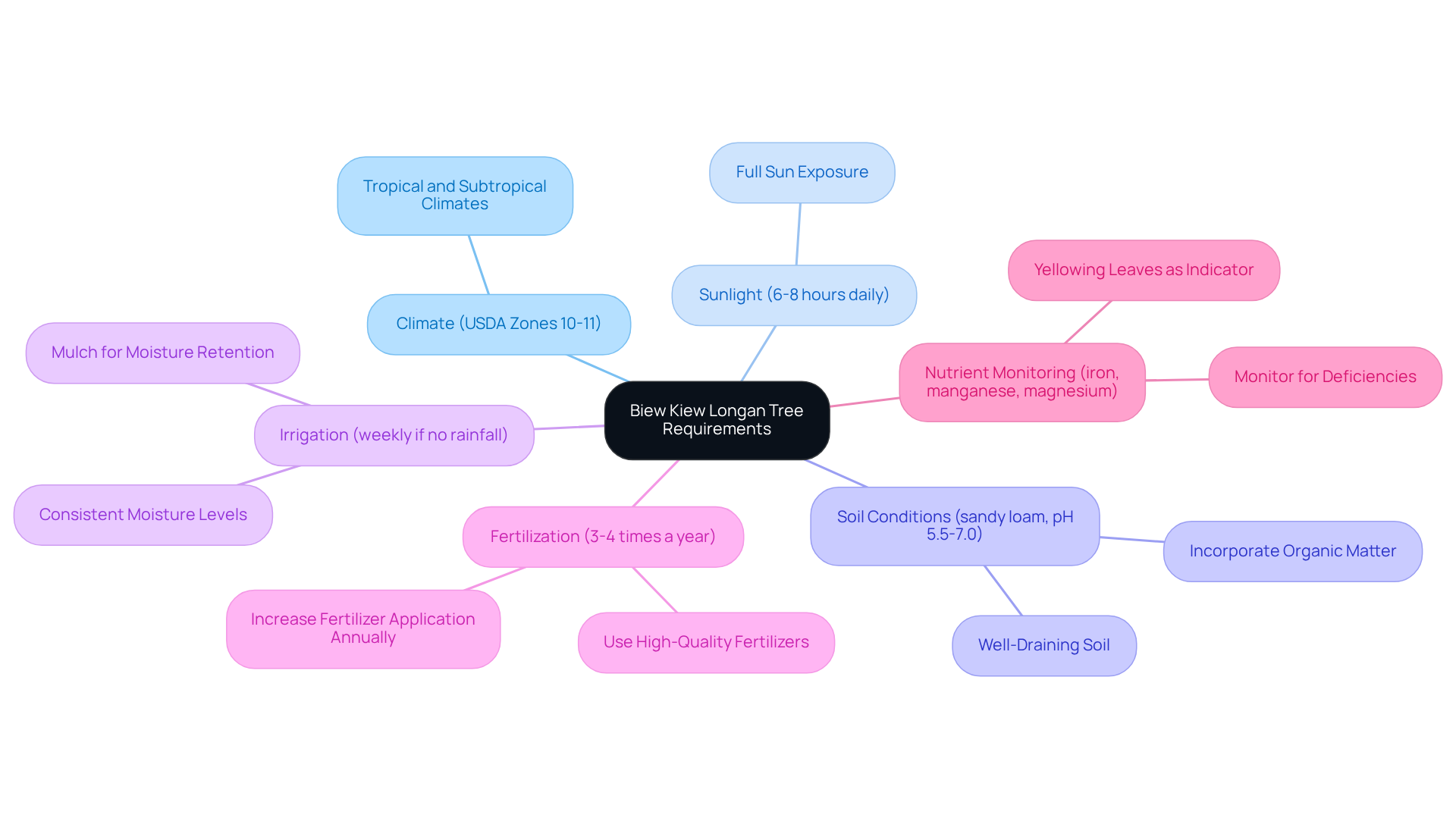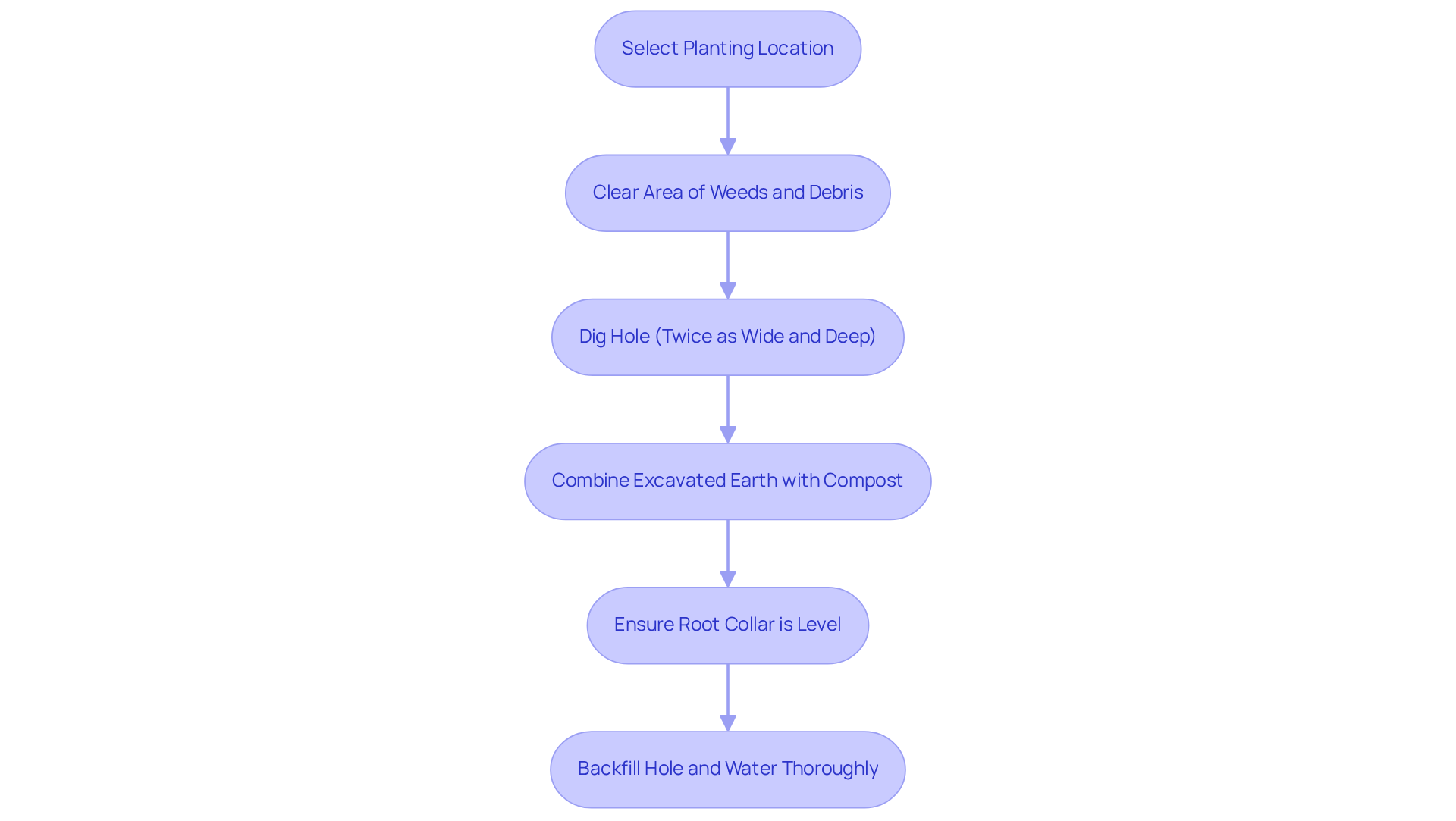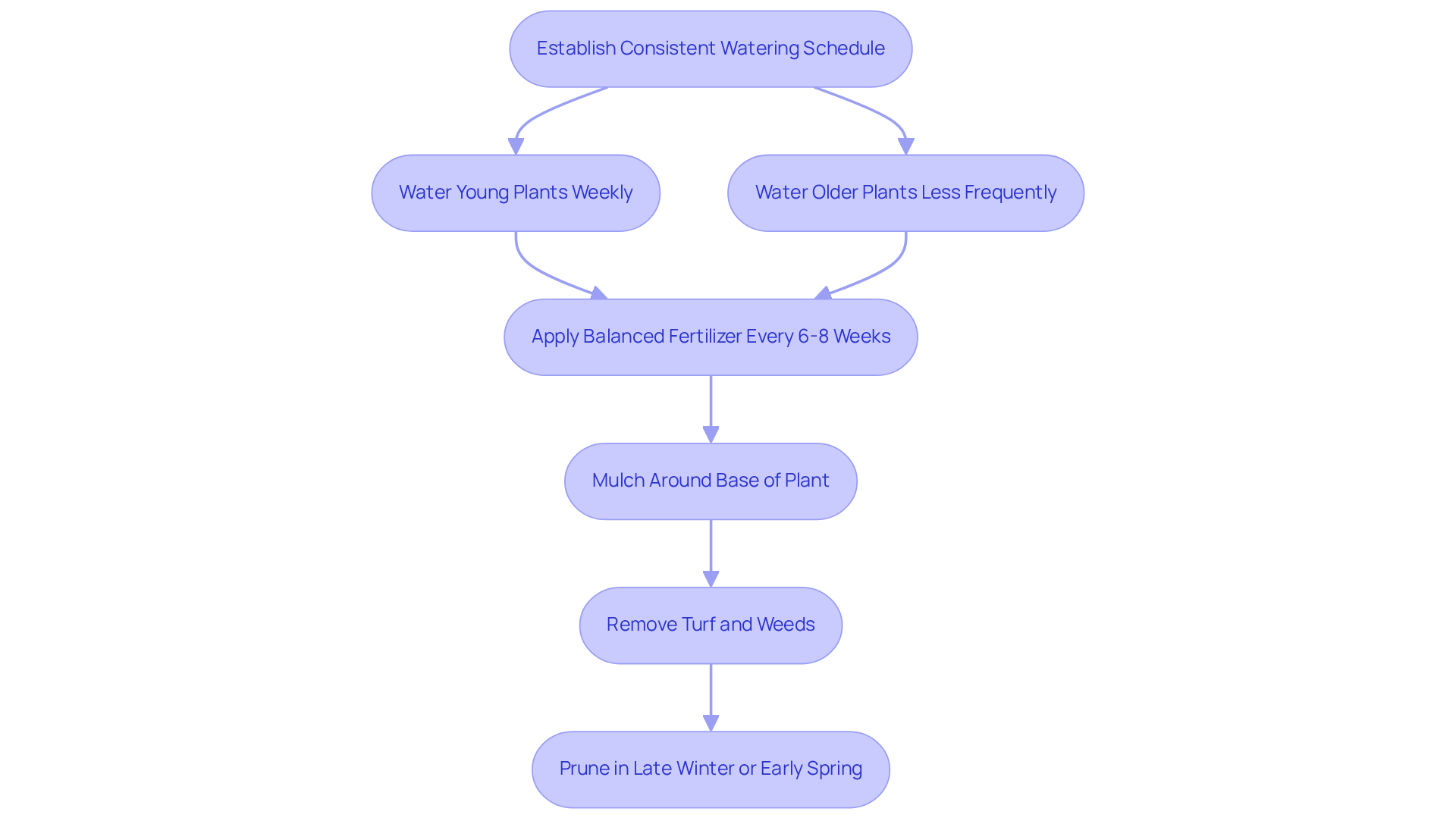The Biew Kiew Longan tree, celebrated for its luscious fruit and tropical appeal, offers a rewarding challenge for gardeners eager to cultivate this exotic plant. Understanding the specific climate and soil requirements is merely the starting point; successful growth relies on a series of essential practices that promote optimal health and productivity.
However, with the potential for pests and diseases lurking at every turn, how can one effectively navigate the complexities of nurturing this delicate tree?
Explore the essential steps for mastering the growth of Biew Kiew Longan, and uncover the secrets to a flourishing tropical garden.
Explore the Biew Kiew Longan at Everglades Farm - shipped directly from Florida.
1. Understand Climate and Soil Requirements
The Biew Kiew Longan tree thrives in USDA hardiness zones 10-11, known for their tropical and subtropical climates. This tree flourishes in full sun, requiring at least 6-8 hours of direct sunlight daily. Ideal soil conditions comprise well-draining sandy loam or clay loam, with a slightly acidic to neutral pH range of 5.5 to 7.0. To prepare the ground, it is essential to till thoroughly and incorporate , such as compost, to enhance both fertility and drainage.
Regular monitoring of soil moisture is crucial, as the Biew Kiew Longan thrives best with consistent moisture levels while avoiding waterlogging. Irrigation should occur weekly if there has been no rainfall of at least 1 inch. Additionally, fertilization should take place three to four times a year using high-quality fertilizers from Everglades Farm to promote healthy development. Nutrient deficiencies, particularly in iron, manganese, and magnesium, can result in yellowing leaves, making it vital to monitor the tree's health closely.
Applying a thick layer of mulch around the base of the tree helps retain moisture and suppress weeds, which encourages successful growth. For those interested in enhancing their tropical gardening experience, consider exploring Everglades Farm's Fast-Growing Trees collection, featuring a variety of rapid-yield tropical plants, including the Kohala.

2. Select and Prepare the Planting Site
Choosing the appropriate planting location for biew kiew longan plants is essential for their development and productivity. It is important to select a site that is protected from strong winds while ensuring good air circulation, as this encourages healthy plant growth. Begin by clearing the area of weeds, debris, and any competing vegetation that could hinder growth.
When preparing the planting hole, follow these steps:
- Dig a hole that is twice as wide and deep as the root ball of the young sapling. This allows for ample space for root expansion, which is crucial for the plant's health.
- To , combine the excavated earth with compost before positioning the plant in the hole.
- Ensure that the root collar is level with the surrounding ground to prevent water buildup around the trunk.
After placing the plant, backfill the hole with the amended soil and water thoroughly to remove any air pockets, which can hinder root establishment. Appropriate site choice and preparation are essential steps that greatly affect the success of your cultivation of this fruit. By following these guidelines, you can create an optimal environment for your biew kiew longan plants to flourish.

3. Implement Care and Maintenance Practices
To ensure the health and productivity of your Biew Kiew Longan plant, it is crucial to establish a consistent watering schedule, particularly during dry spells. Young plants require , while older ones can be irrigated less frequently, allowing the soil to dry slightly between sessions. For instance, a tree with a 2-inch trunk caliper needs 2-3 gallons of water at each watering. This method helps prevent root rot and promotes deep root development, which is essential for long-term resilience.
Fertilization is equally important; applying a balanced fertilizer every 6-8 weeks during the growing season fosters strong development and fruit production. Agronomists recommend that the fertilizer should be rich in nitrogen, phosphorus, and potassium to meet the nutritional needs of tropical fruit plants. Additionally, mulching around the base of the plant retains moisture in the soil and suppresses weed growth, creating a healthier environment for your plant. Laura Irish-Hanson emphasizes that proper mulching aids in regulating soil moisture and reducing weed pressure, further enhancing plant health.
Removing turf and weeds from the base of the plant is essential, as this practice improves root production and water uptake. Pruning should occur in late winter or early spring to eliminate any dead or diseased branches and shape the plant for optimal sunlight exposure. This practice enhances air circulation and light penetration, both of which are vital for fruit development. Brandon Miller notes that newly planted saplings require regular and consistent watering until their root systems are established. By following these care and maintenance practices, you can nurture a thriving biew kiew longan plant that yields delicious fruit for years to come.

4. Manage Pests and Diseases Effectively
To ensure the health of your Biew Kiew longan plants, regular inspections for pests such as aphids, scale insects, and fruit borers are essential. Research indicates that pests of longan can cause 50 to 100% crop losses without timely interventions, underscoring the urgency of effective pest management. Upon detecting an infestation, promptly treat it with like neem oil or insecticidal soap, which have proven effective in managing these pests. As Hanh Tran notes, "Pests of longan are known to cause 50 to 100% crop losses unless timely interventions are implemented."
Maintaining good sanitation practices is equally important; remove fallen leaves and debris that can harbor pests and diseases. For disease prevention, ensure adequate air circulation around the plant and avoid overhead watering to minimize humidity levels that can foster fungal growth. If outbreaks occur, apply fungicides according to label instructions to effectively manage the situation.
Incorporating integrated pest management (IPM) strategies, such as fruit bagging, can further enhance your pest control efforts. Case studies have shown that growers utilizing these organic solutions have successfully minimized crop losses and enhanced fruit quality. By adopting these practices, you can cultivate a thriving Biew Kiew longan tree that produces an abundant yield of fruit.
Conclusion
Mastering the growth of the Biew Kiew Longan tree requires a comprehensive understanding of its specific climate, soil, and care requirements. Successfully cultivating this tropical gem not only yields delicious fruit but also enriches the gardening experience. By concentrating on the essential steps outlined, anyone can create an environment conducive to the thriving of this remarkable tree.
Key insights from the article underscore the importance of:
- Selecting the right planting site
- Ensuring optimal soil conditions
- Implementing effective care and maintenance practices
Regular monitoring of moisture levels, appropriate fertilization, and vigilant pest management are crucial for the health and productivity of the Biew Kiew Longan. Each of these steps contributes to a robust plant that can withstand challenges and produce high-quality fruit.
In conclusion, adopting these best practices for Biew Kiew Longan cultivation transcends mere planting; it involves nurturing a living organism that necessitates attention and care. Embrace the journey of growing this exceptional fruit tree, and take the initial steps today to ensure a bountiful harvest and a vibrant addition to your garden. Whether you are a seasoned gardener or a novice, the rewards of cultivating Biew Kiew Longan are undoubtedly worth the effort.
Start Your Tropical Garden Journey Today!
Cultivate the Biew Kiew Longan and enjoy delicious fruits with high-quality trees from Everglades Farm.
Frequently Asked Questions
What climate is suitable for the Biew Kiew Longan tree?
The Biew Kiew Longan tree thrives in USDA hardiness zones 10-11, which are characterized by tropical and subtropical climates.
How much sunlight does the Biew Kiew Longan tree need?
This tree requires at least 6-8 hours of direct sunlight daily to flourish.
What type of soil is ideal for planting a Biew Kiew Longan tree?
The ideal soil conditions include well-draining sandy loam or clay loam, with a slightly acidic to neutral pH range of 5.5 to 7.0.
How should the ground be prepared for planting the Biew Kiew Longan tree?
The ground should be thoroughly tilled and incorporate organic matter, such as compost, to enhance fertility and drainage.
How important is soil moisture for the Biew Kiew Longan tree?
Regular monitoring of soil moisture is crucial, as the tree thrives best with consistent moisture levels while avoiding waterlogging.
How often should the Biew Kiew Longan tree be irrigated?
Irrigation should occur weekly if there has been no rainfall of at least 1 inch.
When should the Biew Kiew Longan tree be fertilized?
Fertilization should take place three to four times a year using high-quality fertilizers to promote healthy development.
What nutrient deficiencies should be monitored in the Biew Kiew Longan tree?
Nutrient deficiencies in iron, manganese, and magnesium can result in yellowing leaves, so it is vital to monitor the tree's health closely.
How can mulch benefit the Biew Kiew Longan tree?
Applying a thick layer of mulch around the base of the tree helps retain moisture and suppress weeds, which encourages successful growth.
Where can I find more tropical plants to enhance my gardening experience?
Consider exploring Everglades Farm's Fast-Growing Trees collection, which features a variety of rapid-yield tropical plants, including the Kohala.





0 comments